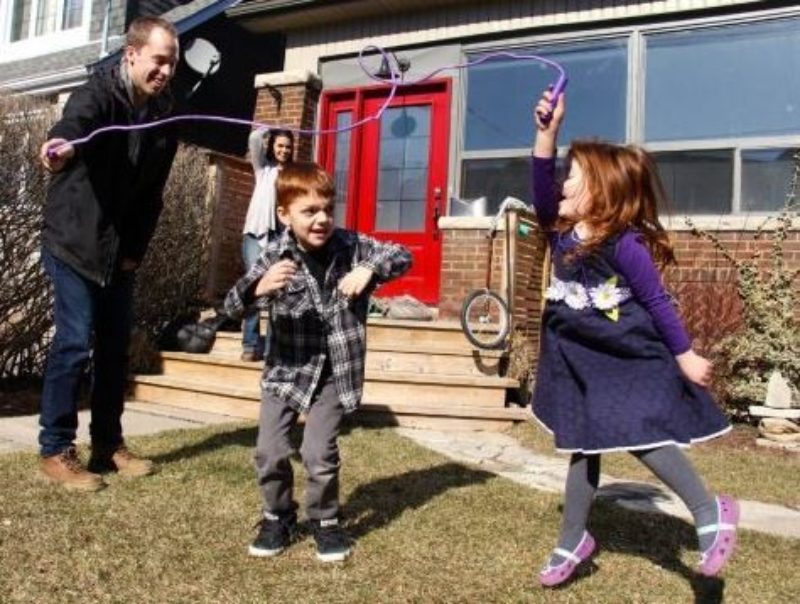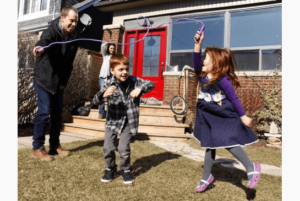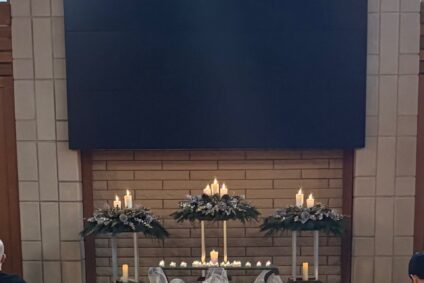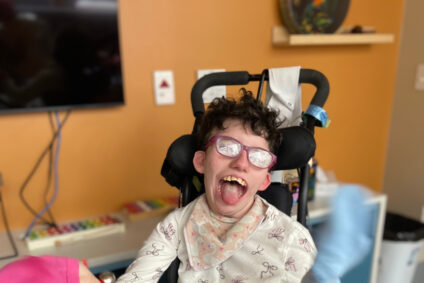Good days and bad for Hunter at hospice

Emily’s House cares for children with complex, terminal illnesses, and offers their parents some respite

Catherine Porter / Toronto Star
Hunter Kemp, 8, tries to skip with his sister Willow and his volunteer caregiver, Taylor Peat, as his mother Sitara de Gagne looks on. Hunter still has debilitating pain in his legs from treatment for leukemia, which ended two years ago.
Catherine Porter Columnist, Published on Mon Apr 20 2015, in The Toronto Star
Hunter Kemp has two types of days.
“He couldn’t walk yesterday, the pain was so bad. He was screaming and crying,” says his mother, Sitara de Gagne, watching Hunter attempt jump rope with his little sister, Willow, and Taylor Peat.
Today is a good one. The eight-year-old spent his morning at a camp program for kids with cancer, and he has energy to burn. He wants Peat to climb the back-yard jungle gym with him.
Peat is a 28-year-old engineer who visits once a week to play with Hunter.
He’s not a cousin or old family friend; he’s a volunteer with Emily’s House, Toronto’s children’s hospice which opened two years ago.
The hospice has only six government-funded beds — regularly filled by children with complex, terminal illnesses. For the parents of those children, it offers respite — a chance, for once, to go out on a date night or sleep in, knowing their child is in loving, capable hands.
But there are far more than six terminally ill children in this city. For them, Emily’s House trains volunteers and sends them on home visits.
They might do laundry or run errands or tube-feed the child.
Or they might just play, so someone such as de Gagne can step into a luxurious shower and escape her anxiety for a few minutes.
“Sometimes I just watch them play,” says de Gagne. “It’s such a blessing to see Hunter play and be care free.”
I first heard about the community volunteer program while touring Emily’s House, a stunning place, full of light and warmth, in the renovated stone Governor’s House, across from the old Don Jail.
There are 25 full-time staff at Emily’s House. There are around 200 volunteers trained to work with children. They keep the place running.
Who are these people who chose to spend their free time bonding with dying children?
Just looking through the volunteer training program is enough to make you blanch; it’s 54 hours long! Volunteers learn practical nursing skills — transferring and diapering — but then there are the sections on “signs and symptoms of imminent of death,” “anticipatory grief/bereavement” and “ethics.”
I asked Amanda Maragos, manager of volunteer services, what that last category might entail. She gives an example of visiting a 11-year-old dying of cancer who says: “I know I’m dying, even through my parents don’t want to talk about it.”
Hunter is not a typical client, because he is not dying. He finished chemotherapy two years ago for leukemia. De Gagne unpacked the hospital bag that stood sentry at the front door for five years.
But the family is stuck in cancer’s terrible shadow. Hunter misses every other day of school because of extreme fatigue or terrible pain in his legs and back — after-effects of chemotherapy, de Gagne says. He needs to be carried to the bathroom at night.
His weeks include pain management sessions and physiotherapy, instead of IV-hydration and chemotherapy.
“For Hunter, in a lot of ways, life didn’t get better after treatment; it was worse,” says de Gagne, who left her job at a financial-planning firm the day Hunter was diagnosed, and never returned.
After six years of tending to Hunter, she is exhausted and strung out, and there is no end in sight.
On bad days, Peat sits on the couch and reads to Hunter. Or they play cards.
“It gives you perspective on the problems in your life,” says Peat.
Like many of Emily House’s volunteers, Peat has had his own personal brush with death; when he was 18, his older brother died of lung cancer.
He watched his mother struggle. He wanted to help another family in the same circumstances.
There is a tenderness induced by suffering and death’s approach. He is continually touched by de Gagne’s loving patience with Hunter, Peat says.
“It’s crazy how much work she does,” he says. “It can be inspiring; the worst situation can bring out the best in people.”
But today is a good day, and good days must be relished. Hunter wants to build a fort down in Taylor Creek ravine behind his family home. So off they go, with Willow in tow.
“I think I’m going to slip inside and make a cup of tea,” says de Gagne.
We agree: Emily’s House volunteers are angels.
Catherine Porter can be reached at cporter@thestar.ca


